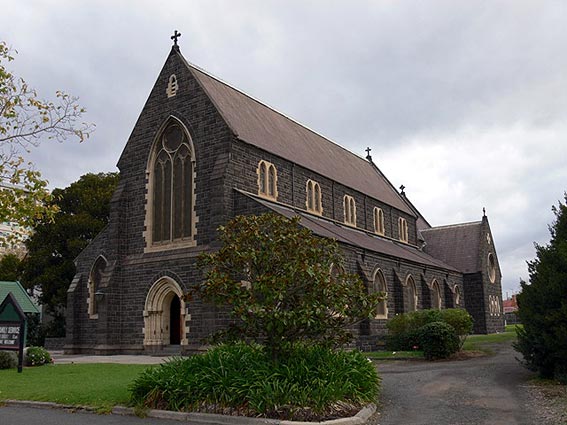
Holy Trinity Anglican Church, Williamstown: exterior from the north-east
[photograph by John Maidment (2 June 2006)]
Historical and Technical Documentation by John Maidment
© OHTA, 2007 (last updated February 2016)

Holy Trinity Anglican Church, Williamstown: exterior from the north-east
[photograph by John Maidment (2 June 2006)]
Holy Trinity Church was designed by the noted architect Leonard Terry and built 1871-74. Built in bluestone with freestone dressings in the Decorated Gothic style, it comprises a tall clerestoried nave of five bays, a raised chancel and organ chamber to the right.1 Unfortunately the planned tower and spire were not built. The interior includes cedar fittings and a window designed and made by the renowned artist Napier Waller.
It was reported in January 1855 that a neat four-stopped pipe organ had been placed in the gallery of the first church, made from prefabricated iron.2 This was replaced by a single manual organ of 6 stops built by Jesse Biggs that was installed in 1857.
Organ Building. — The multiplication of new churches, and the daily increasing taste for congregational music, is gradually creating a demand for organs suited to churches of moderate size, and, we may say, suited to congregations of moderate means. Mr J. Biggs, organ builder, of Little Lonsdale street west, who gained his experience in the works of Messrs. Gray and Davison, of London, has just completed a compact little organ of seven stops, which, in addition to the qualifications we have mentioned, possesses great power, combined with richness of tone. The organ has been tuned to an equal temperament under the direction of Mr George Loder, and so voiced as to insure a large volume of sound without any harshness. The stops consist of the open diapason, the stopped diapason, treble and bass, principal, cornopean, fifteenth, and bourdon pedal pipes. There is also an octave of German pedals. As all the various ranks of pipes are enclosed in a 'swell' the performer has it in his power to impart great additional effect to his playing. By this contrivance also the dust is prevented from falling into the reeds, choking them up, and preventing them from speaking. This arrangement is specially necessary in so dusty a colony. The pedal pipes are of course of wood, and constructed upon the principle of making an eight feet pipe give forth the sound usually had from double one of that length. The organ has been constructed of wood seasoned in the colony, as from the variations in climate, it is unsafe to import any wood already made up in Great Britain, on account of its tendency to shrink. We understand that Mr Biggs has sold the organ, and expects very shortly to have to proceed with several others. We have chosen to make this special record of the completing of an organ, as we believe it to be the first actually built in the colonies by a practical man, and as such, another instance of colonial enterprise which we should be delighted to see fully rewarded. The organ will remain on view for a few days at Mr Biggs' residence in Little Lonsdale street, beyond King-street.3
Trinity Church, Williamstown. — Some weeks ago we did ourselves the pleasure of mentioning in terms of high commendation an organ of equal sweetness and power just completed by Mr J. Biggs, organbuilder, Melbourne, a pupil of the eminent firm of Gray and Davison of London. The organ had besides received the favorable testimony of Mr George Loder, the accomplished director of Madame Anna Bishop's operatic entertainments, and other persons well qualified to judge. We were therefore not at all surprised to hear of its purchase by the congregation of Trinity Church, Williamstown, who were naturally anxious to secure to themselves a better instrument than that to which they had been accustomed. The organ, which is the first built in the colony by an experienced maker, was opened on Sunday last by Bishop Perry, who preached sermons to crowded audiences in the evening as well as the morning, and made them the vehicle of some very earnest and judicious exhortations on the propriety of joining heart and soul in the practice of congregational singing. The organ was very skilfully played by Mr Michael Ashton, and the collections during the two services amounted to £20. The price of the instrument is £200, of which the greater part has already been collected and paid. The church is now undergoing thorough repair at an expense of £100.4
From the above account, it would appear that the second organ at Holy Trinity Church had the following specification:
| MANUAL Open Diapason Stopped Diapason Bass Stopped Diapason Treble Principal Fifteenth Cornopean PEDAL Bourdon |
8 8 8 4 2 8 16 |
The instrument was probably traded in to William Anderson who is likely to have used parts in other instruments, maybe even that in St Mary's Catholic Church, Williamstown.
This was replaced in 1896 with the present organ built by William Anderson which remains one of his largest unaltered instruments. It was opened on Thursday evening 17 September 1896.5 The details of the cedar console stop jambs and scrolled key cheeks appear identical with a larger instrument now at the Old Museum Building, Brisbane and for many years in St Stephen's Cathedral in that city. The casework, with three flats, is similar to that of the Brisbane instrument, with almost identical terminations to the uprights. George Fincham supplied the following pipework to Mr Anderson on 22 March 1895,6 and it seems that this may have been for this instrument:
No 1 1 2 1 1 2 2 |
Gt Open Principal Dulciana 12th 15th Swl Oboe ten. C Open Gemshorn Piccolo front - |
45 (sic) 56 44 56 56 44 44 56 12 11 pipes |
The instrument remains unaltered from the original apart from the overpainting of the façade pipes (the two lateral flats of five pipes are dummies) and the insertion of an 1898 George Fincham Clarionet on the Great, occupying a spare slide; this stop came from the organ originally in St Patrick's Catholic Cathedral, Ballarat and later in St James' Anglican Church, Dandenong.

Holy Trinity Anglican Church, Williamstown: organ
[photograph by Trevor Bunning (January 2013)]
| GREAT Open Diapason Stop Diapason Clarabella Dulciana Principal Flute Twelfth Fifteenth Clarionet Swell to Great SWELL Open Diapason Stop’d Diapason Gemshorn Piccolo Hautboy PEDAL Bourdon Pedals to Great Swell to Pedals |
[8] [8] [8] [8] [4] [4] [2-2/3] [2] [8] [8] [8] [4] [2] [8] [16] |
Bass CC-BB TC TC gvd bass TC |
Compass: 56/30
3 composition pedals to Great
Internal metal pipework of spotted metal, cone tuned
Trigger swell lever
Mechanical key and stop action7
1 Victorian Churches, edited by Miles Lewis. East Melbourne; National Trust of Australia (Victoria), 1991, p. 88
2 The Argus, 2 January 1855, p.5
3 The Age, 1 July 1857, p.5
4 The Age, 31 July 1857, p.6
5 Williamstown Chronicle, 19 September 1896, p.2
6 George Fincham correspondence (State Library of Victoria)
7 Details noted by John Maidment 1966
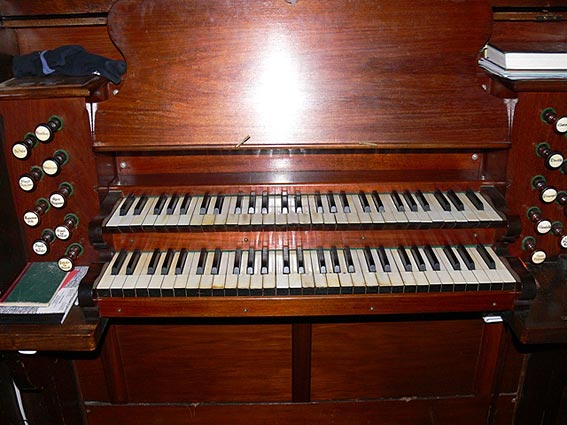
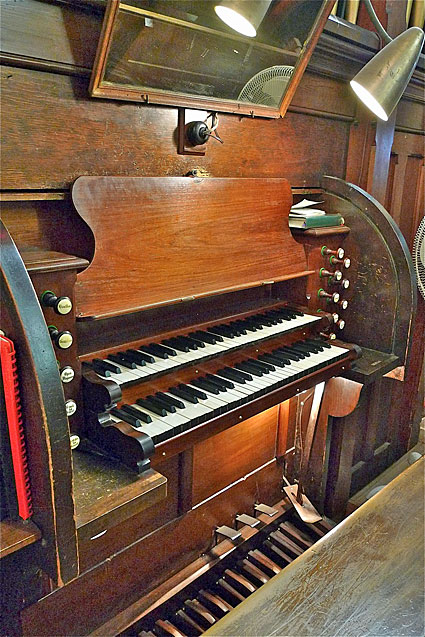
Holy Trinity Anglican Church, Williamstown: console
[photographs by Trevor Bunning (January 2013)]
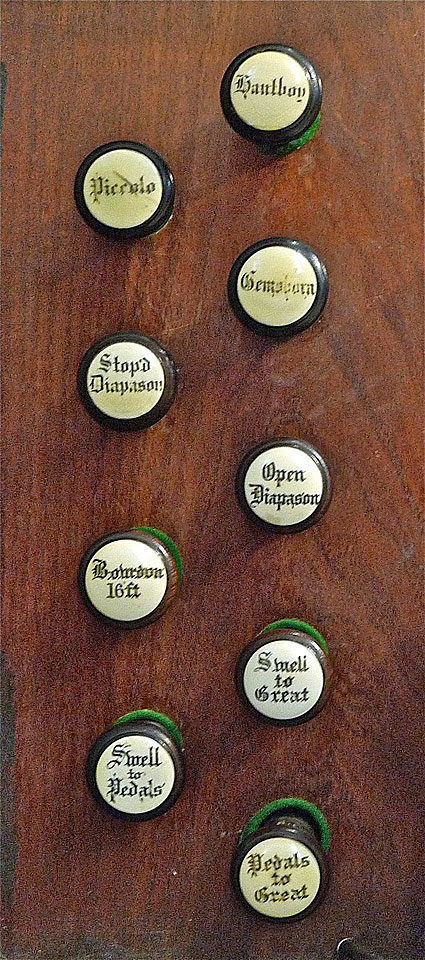
Holy Trinity Anglican Church, Williamstown: left stop jamb
[photograph by Trevor Bunning (January 2013)]
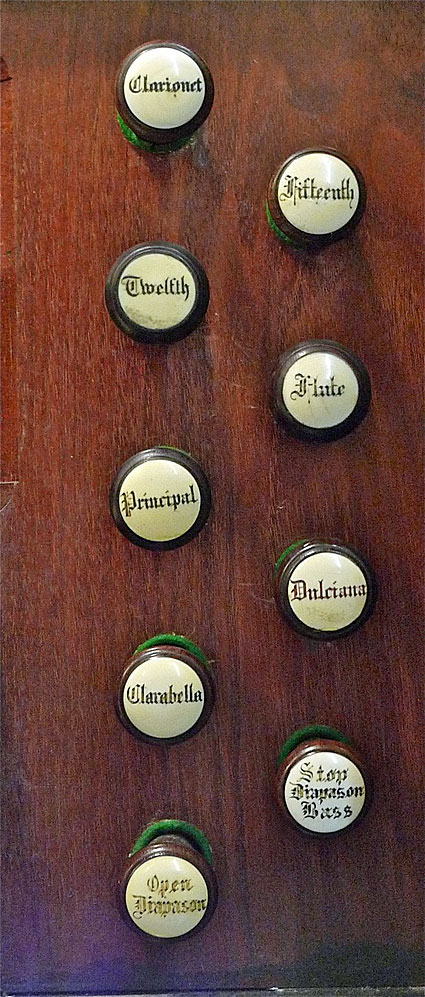
Holy Trinity Anglican Church, Williamstown: right-hand stop jamb
[photograph by Trevor Bunning (January 2013)]
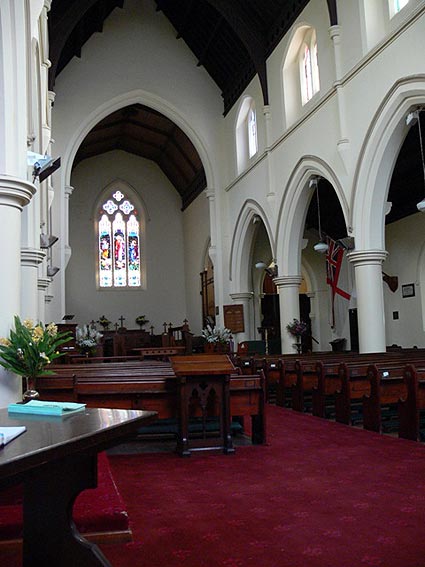
Holy Trinity Anglican Church, Williamstown: interior from the west
[photograph by John Maidment (2 June 2006)]

Holy Trinity Anglican Church, Williamstown: detail of window made by Napier Waller
[photograph by John Maidment (2 June 2006)]
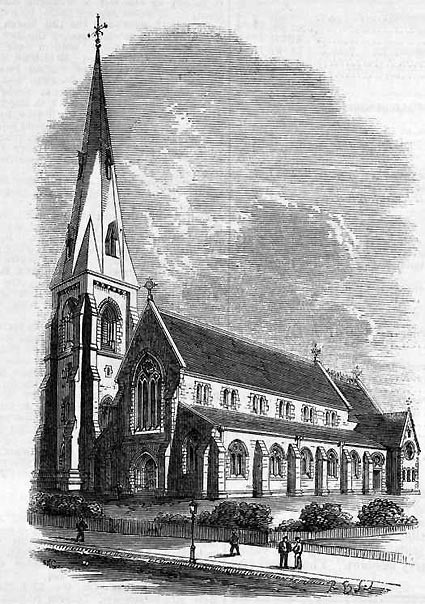
Holy Trinity Anglican Church, Williamstown: drawing by A.C. Cooke showing the intended tower and spire that were never built
The Illustrated Australian News for Home Readers 23 April 1872